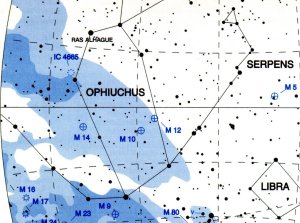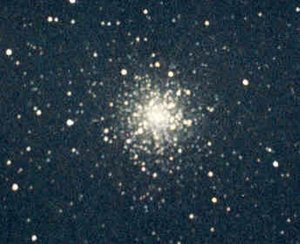The American Association of Amateur Astronomers
The Constellations of Ophiucus and
Serpens
 Ophiucus and
Serpens are two constellations which lie on or along
the summer Milky Way. As they lie near the center of our galaxy, the area is abundant in globular clusters, which
are concentrated around that center. While many observers think that all globulars look alike, careful observations
show that each has its own peculiarities which distinguish it from its brethren. Spend some time with these objects
to learn their individual characteristics, and don't be afraid to use high powers. Their very nature invites you
discern their structure with the finer resolution available through higher magnification. The constellation of
Serpens is notable in that it is the only constellation which is divided into two parts. Ophiucus and
Serpens are two constellations which lie on or along
the summer Milky Way. As they lie near the center of our galaxy, the area is abundant in globular clusters, which
are concentrated around that center. While many observers think that all globulars look alike, careful observations
show that each has its own peculiarities which distinguish it from its brethren. Spend some time with these objects
to learn their individual characteristics, and don't be afraid to use high powers. Their very nature invites you
discern their structure with the finer resolution available through higher magnification. The constellation of
Serpens is notable in that it is the only constellation which is divided into two parts.
Ophiuchus, the Serpent Bearer, separates Serpens (Caput), the Serpent's Head, from Serpens (Cauda), the Serpent's
Tail. This area is not only rich in mythology, but also warrants attention while waiting for Sagittarius
and the heart of the Milky Way to rise.
OPHIUCHUS
Finding star clusters in Ophiuchus can be done faster than trying to figure out how to pronounce this constellation's name. There are many Messier Objects in Ophiuchus, but M12 is probably one of the more stunning. Look for this 8th magnitude globular cluster two degrees north and 8.5 degrees east of Delta Ophiuchi. While you are there, look for the globular clusters M10 and M14 nearby. These globulars are part of our Milky Way’s galactic halo.
(Brenda Culbertson.)
M-9. This globular cluster is about 6-8' in diameter, roughly circular, with some resolution at the edges.
The core is unresolved in my scope, and is somewhat kidney bean shaped, and is elongated in the north to south
direction. Under a clear, dark sky, see if you can find Barnard 64, the dark nebula upon which M-9 is superimposed.
I saw it as an amorphous region, about 3/4 of a degree in extent, which is almost devoid of stars just to the west
of the globular, and ever so slightly darker than the surrounding sky background.
|

M-10 - This fine globular is rather well resolved even at low powers. It is about 12' in diameter, and has
a rather ragged circular shape with stars resolved across its face. A chain of 6 foreground stars starts north
of the globular and ends to its south, seemingly bisecting the cluster. Photo by
AAAA member Mark Cunningham of Craig, Colorado |

M-12 - Lying only a few degrees away from M-10, this object is slightly smaller, about 8-10' in diameter.
It is also well resolved across its face, and is somewhat looser than that object. It is basically circular and
has a granular center. Photo by AAAA member Mark Cunningham of Craig,
Colorado |
M-14 - This object yielded the least amount of detail in my telescope. It is about 8' in diameter, with
resolution hinted at the edges at 179X. Little detail other than a granular core was noted.
M-19 - This globular appeared as an milky patch of light about 8' in diameter, with resolution around the
edges. Its granular core is flanked by two stars, one to the northwest, and one to the northeast, and appears somewhat
ovoid in shape.
M-62 - A fine, bright globular cluster with resolution at the edges, and a bright core. About 10' in diameter,
this cluster's core is slightly offset to the southeast. Stars seem to fan out to the west, giving this globular
rather unique appearance.
M-107 - This moderately faint object needed a high power and averted vision to yield resolution. It is about
8' in diameter, and is slightly flattened on its northern edge. The brightest area appears to be in the southwestern
corner.
NGC 6369 - This is a moderately bright planetary nebula which is almost 1' in diameter. It appears as a
grey puff of light which, with averted vision, has a darker center suggesting annularity (a ring shape). Try high
powers on this object.
Article © Copyright Rick Raasch
Photos and Text © Copyright Edward P. Flaspoehler, Jr.
Messier Objects in Ophiucus
|
Con
|
Messier
|
Type
|
R.A.
|
Dec.
|
Mag.
|
Size
|
NGC#
|
|
Oph
|
M9
|
Globular Cluster
|
17h 19.2
|
-18d 31
|
9.0
|
9.3'
|
6333
|
|
Oph
|
M10
|
Globular Cluster
|
16h 57.1
|
-4d 6
|
7.5
|
15.1'
|
6254
|
|
Oph
|
M12
|
Globular Cluster
|
16h 47.2
|
-1d 57
|
8.0
|
14.5'
|
6218
|
|
Oph
|
M14
|
Globular Cluster
|
17h 37.6
|
-3d 15
|
9.5
|
11.7'
|
6402
|
|
Oph
|
M19
|
Globular Cluster
|
17h 2.6
|
-26d 16
|
8.5
|
13.5'
|
6273
|
|
Oph
|
M62
|
Globular Cluster
|
17h 1.2
|
-30d 7
|
8.0
|
14.1'
|
6266
|
|
Oph
|
M107
|
Globular Cluster
|
16h 32.5
|
-13d 3
|
10.0
|
10.0'
|
6171
|
The Constellation Home Page
Sponsored by the American Association of Amateur Astronomers.
EDITOR: Edward P. Flaspoehler, Jr.
Help support the development of the Constellation Home Page.
Become a member of the American Association
of Amateur Astronomers.
To join, send your name and address along with y our check for $20.00 ($25.00 family)
to the following address.
Unless otherwise indicated:
All Content © Copyright 1998 by The American Association of Amateur Astronomers
All rights reserved.
Go to Top of Constellation Home Page |